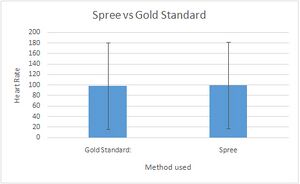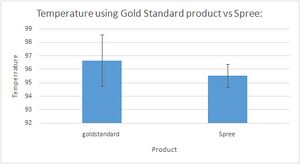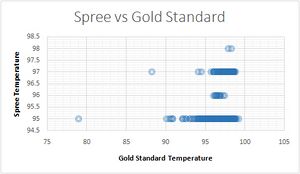BME100 f2016:Group12 W8AM L3
| Home People Lab Write-Up 1 | Lab Write-Up 2 | Lab Write-Up 3 Lab Write-Up 4 | Lab Write-Up 5 | Lab Write-Up 6 Course Logistics For Instructors Photos Wiki Editing Help | ||||||
|
OUR TEAM
LAB 3 WRITE-UPDescriptive Stats and GraphHeart Rate Temperature
Inferential Statsp-value(paired) 0.265205582 Since the p-value is over .05, it is not statistically significant. p-value(paired) 1.09676E-21 p-value(unpaired) 1.85543E-20
Design Flaws and RecommendationsFlaws - Not appeasing to the eye - Inaccurate readouts, including - Heart Rate
- Temperature
- Over Selling what it can actually do. Recommendations -Change Locations -Changing where the sensors are located, such as placing them on the temples. They are softer, and where most at home thermometers are used. -Change design of the product and where it is located, improving aesthetics, as well as functionality, as there are many technologies that fit on wrist and are accurate. -Change the description of the device - Say it is only a rough read out, and is not entirely accurate. Honesty is very important, and is very likely that the company would get a bad reputation for putting out a product that didn't work, or at least most of the time didn't. -Change Marketing -How it is sold, and to what audience it is being sold to - The price, so that what the customer is getting is closer to what he paid for.
Experimental Design of Own DeviceAn experiment we could run to test our prototype is by testing the way we plan to administer medication. The way our prototype works is by injecting the medication directly into the patient's bloodstream. In order to determine the efficiency of administering medicine via injection into the bloodstream versus the typical way of ingesting a pill, we would need to take multiple groups of people both taking pills and being injected with the medicine. These groups would be given different doses of the medication and tested on how quickly the effects of the medicine take hold. Not only would we determine how quickly the medication works, but we could also determine how effectively the medication is being absorbed by the patient's body. If it turns out that injecting the medicine, like our prototype does, is more effective than just taking pills, then that would be a proof of concept that our device will be effective and impactful on the health of the patient. | ||||||





